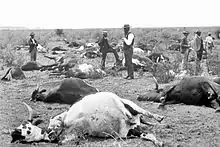1890s African rinderpest epizootic
In the 1890s, an epizootic of the rinderpest virus struck Africa, considered to be "the most devastating epidemic to hit southern Africa in the late nineteenth century".[1] It killed more than 5.2 million cattle south of the Zambezi,[2] as well as domestic oxen, sheep, and goats, and wild populations of buffalo, giraffe, and wildebeest. This led to starvation resulting in the death of an estimated third of the human population of Ethiopia and two-thirds of the Maasai people of Tanzania.[3]

Cattle dead from rinderpest in South Africa, 1896
History
The virus is thought to have been introduced into Eritrea in 1887 by Indian cattle brought by the Italians for their campaign against Somalia. It spread throughout the Horn of Africa, and crossed the Zambezi in March of 1896.[1]
References
- Phoofolo, Pule (February 1993). "Epidemics and Revolutions: The Rinderpest Epidemic in Late Nineteenth-Century Southern Africa". Past & Present. 138 (1): 112–143. doi:10.1093/past/138.1.112.
- Van den Bossche, Peter; de La Rocque, Stéphane; Hendrickx, Guy; Bouyer, Jérémy (May 2010). "A changing environment and the epidemiology of tsetse-transmitted livestock trypanosomiasis". Trends in Parasitology. 26 (5): 236–243. doi:10.1016/j.pt.2010.02.010.
- Normile, Dennis (March 2008). "Driven to Extinction". Science. 319: 1606–9. doi:10.1126/science.319.5870.1606. PMID 18356500.
Further reading
- Sunseri, Thaddeus (2018-04-26). "The African Rinderpest Panzootic, 1888–1897". Oxford Research Encyclopedia of African History. Oxford University Press. doi:10.1093/acrefore/9780190277734.013.375.
This article is issued from Wikipedia. The text is licensed under Creative Commons - Attribution - Sharealike. Additional terms may apply for the media files.